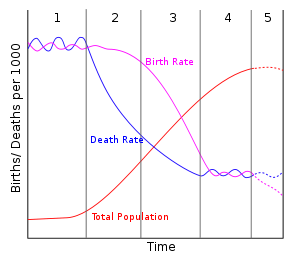
Epidemiological transition
Encyclopedia

Demography
Demography is the statistical study of human population. It can be a very general science that can be applied to any kind of dynamic human population, that is, one that changes over time or space...
and medical geography, epidemiological transition is a phase of development witnessed by a sudden and stark increase in population growth rates brought about by medical innovation in disease or sickness therapy and treatment, followed by a re-leveling of population growth from subsequent declines in fertility rates. This theory was originally posited by Abdel R Omran in 1971.
Theory
Omran divided the epidemiological transition of mortality into three phases, in the last of which chronic diseases replace infection as the primary cause of death. These phases are:- The Age of Pestilence and Famine: Where mortality is high and fluctuating, precluding sustained population growth, with low and variable life expectancy, vascillating between 20 and 40 years.
- The Age of Receding Pandemics: Where mortality progressively declines, with the rate of decline accelerating as epidemic peaks decrease in frequency. Average life expectancy increases steadily from about 30 to 50 years. Population growth is sustained and begins to be exponential.
- The Age of Degenerative and Man-Made Diseases: Mortality continues to decline and eventually approaches stability at a relatively low level. Life expectancy rises and exceeds 50 years, with fertility becoming the crucial factor in population growth.
The epidemiological transition occurs as a country undergoes the process of modernization from developing nation to developed nation status. The developments of modern healthcare, and medicine like antibiotics, drastically reduces infant mortality rates and extends average life expectancy which, coupled with subsequent declines in fertility rates, reflects a transition to chronic and degenerative diseases as more important causes of death.
History
In general human history, Omran's first phase occurs when human population sustains cyclic, low-growth, and mostly linear, up-and-down patterns associated with wars, famine, epidemic outbreaks, as well as small golden ages, and localized periods of "prosperity". In early pre-agricultural history, infant mortality rates were high and average life expectancyLife expectancy
Life expectancy is the expected number of years of life remaining at a given age. It is denoted by ex, which means the average number of subsequent years of life for someone now aged x, according to a particular mortality experience...
low. Today, life expectancy in third world countries remains relatively low, as in many Sub-Saharan Africa
Sub-Saharan Africa
Sub-Saharan Africa as a geographical term refers to the area of the African continent which lies south of the Sahara. A political definition of Sub-Saharan Africa, instead, covers all African countries which are fully or partially located south of the Sahara...
n nations where it typically doesn't exceed 30 years of age.
The second phase involves advancements in medicine and the devopment of a healthcare system. One treatment breakthrough of note was the discovery of penicillin
Penicillin
Penicillin is a group of antibiotics derived from Penicillium fungi. They include penicillin G, procaine penicillin, benzathine penicillin, and penicillin V....
in the mid 20th century which led to widespread and dramatic declines in death rates from previously serious diseases such as syphilis. Population growth rates surged in the 1950s, 1960s and 1970s, to 1.8% per year and higher, with the world gaining 2 billion people between 1950 and the 1980s alone.
Omran's third phase occurs when human birth rates drastically decline from highly positive replacement numbers to stable replacement rates. In several European nations replacement rates have even become negative. As this transition generally represents the net effect of individual choices on family size (and the ability to implement those choices), it is more complicated. Omran gives three possible factors tending to encourage reduced fertility rates:
- Biophysiologic factors, associated with reduced infant mortaliity and the expectation of longer life in parents,
- Socioeconomic factors, associated with childhood survival and the economic perceptions of large family size, and
- Psychologic or emotional factors, where society as a whole changes its rationale and opinion on family size and parental energies are redirected to qualitative aspects of child-raising.
This transition may also be associated with the sociological adaptations associated with demographic movements to urban areas, and a shift from agriculture and labor based production output to technological and service-sector-based economies.
Regardless, Chronic and degenerative diseases, and accidents and injuries, became more important causes of death. This shift in demographic and disease profiles is currently under way in most developing nations, however every country is unique in its transition speed based on a myriad of geographical and socio-political factors.
See also
- Demographic TransitionDemographic transitionThe demographic transition model is the transition from high birth and death rates to low birth and death rates as a country develops from a pre-industrial to an industrialized economic system. The theory is based on an interpretation of demographic history developed in 1929 by the American...
- Medical AnthropologyMedical anthropologyMedical anthropology is an interdisciplinary field which studies "human health and disease, health care systems, and biocultural adaptation". It views humans from multidimensional and ecological perspectives...
- Medical SociologyMedical sociologyMedical sociology is the sociological analysis of medical organizations and institutions; the production of knowledges and selection of methods, the actions and interactions of healthcare professionals, and the social or cultural effects of medical practice...
- Nutrition TransitionNutrition TransitionIncreased consumption of unhealthy foods compounded with increased prevalence of overweight in middle-to-low-income countries is typically referred to as the “Nutrition Transition.” It occurs in conjunction to the Epidemiological Transition and has serious implications in terms of public health...

